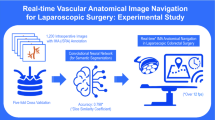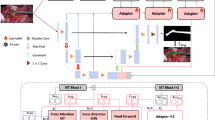Abstract
Appropriate needle manipulation to avoid abrupt deformation of fragile vessels is a critical determinant of the success of microvascular anastomosis. However, no study has yet evaluated the area changes in surgical objects using surgical videos. The present study therefore aimed to develop a deep learning-based semantic segmentation algorithm to assess the area change of vessels during microvascular anastomosis for objective surgical skill assessment with regard to the “respect for tissue.” The semantic segmentation algorithm was trained based on a ResNet-50 network using microvascular end-to-side anastomosis training videos with artificial blood vessels. Using the created model, video parameters during a single stitch completion task, including the coefficient of variation of vessel area (CV-VA), relative change in vessel area per unit time (ΔVA), and the number of tissue deformation errors (TDE), as defined by a ΔVA threshold, were compared between expert and novice surgeons. A high validation accuracy (99.1%) and Intersection over Union (0.93) were obtained for the auto-segmentation model. During the single-stitch task, the expert surgeons displayed lower values of CV-VA (p < 0.05) and ΔVA (p < 0.05). Additionally, experts committed significantly fewer TDEs than novices (p < 0.05), and completed the task in a shorter time (p < 0.01). Receiver operating curve analyses indicated relatively strong discriminative capabilities for each video parameter and task completion time, while the combined use of the task completion time and video parameters demonstrated complete discriminative power between experts and novices. In conclusion, the assessment of changes in the vessel area during microvascular anastomosis using a deep learning-based semantic segmentation algorithm is presented as a novel concept for evaluating microsurgical performance. This will be useful in future computer-aided devices to enhance surgical education and patient safety.





Similar content being viewed by others
Data availability
The data and materials that support the findings of this study are available from the corresponding author upon reasonable request.
References
Aoun SG, El Ahmadieh TY, El Tecle NE, Daou MR, Adel JG, Park CS, Batjer HH, Bendok BR (2015) A pilot study to assess the construct and face validity of the Northwestern Objective Microanastomosis Assessment Tool. J Neurosurg 123:103–109. https://doi.org/10.3171/2014.12.JNS131814
Baghdadi A, Lama S, Singh R, Hoshyarmanesh H, Razmi M, Sutherland GR (2021) A data-driven performance dashboard for surgical dissection. Sci Rep 2021 111 11:1–13. https://doi.org/10.1038/s41598-021-94487-9
Birkmeyer JD, Finks JF, O’Reilly A, Oerline M, Carlin AM, Nunn AR, Dimick J, Banerjee M, Birkmeyer NJO (2013) Surgical skill and complication rates after bariatric surgery. N Engl J Med 369:1434–1442. https://doi.org/10.1056/NEJMsa1300625
Castillo-Segura P, Fernández-Panadero C, Alario-Hoyos C, Muñoz-Merino PJ, Delgado Kloos C (2021) Objective and automated assessment of surgical technical skills with IoT systems: a systematic literature review. Artif Intell Med 112:102007
Curtis NJ, Dennison G, Brown CSB, Hewett PJ, Hanna GB, Stevenson ARL, Francis NK (2019) Clinical evaluation of Intraoperative Near misses in laparoscopic rectal Cancer surgery. Ann Surg XX 1. https://doi.org/10.1097/sla.0000000000003452
Darzi A, Smith S, Taffinder N (1999) Assessing operative skill. Br Med J 318:887–888
Davids J, Makariou SG, Ashrafian H, Darzi A, Marcus HJ, Giannarou S (2021) Automated vision-based Microsurgical Skill Analysis in Neurosurgery using deep learning: development and preclinical validation. World Neurosurg 149:e669–e686. https://doi.org/10.1016/j.wneu.2021.01.117
Fecso AB, Szasz P, Kerezov G, Grantcharov TP (2017) The effect of technical performance on patient outcomes in surgery. Ann Surg 265:492–501. https://doi.org/10.1097/SLA.0000000000001959
Fujimura M, Tominaga T (2021) Flow-augmentation bypass for moyamoya disease. J Neurosurg Sci 65:277–286
Fujimura M, Kaneta T, Tominaga T (2008) Efficacy of superficial temporal artery-middle cerebral artery anastomosis with routine postoperative cerebral blood flow measurement during the acute stage in childhood moyamoya disease. Child’s Nerv Syst 24:827–832. https://doi.org/10.1007/s00381-007-0551-y
Fujimura M, Tominaga T, Kuroda S, Takahashi JC, Endo H, Ogasawara K, Miyamoto S (2022) 2021 Japanese guidelines for the management of Moyamoya Disease: guidelines from the Research Committee on Moyamoya Disease and Japan Stroke Society. Neurol Med Chir (Tokyo) 62:165–170. https://doi.org/10.2176/jns-nmc.2021-0382
Ghasemloonia A, Maddahi Y, Zareinia K, Lama S, Dort JC, Sutherland GR (2017) Surgical Skill Assessment using motion quality and smoothness. J Surg Educ 74:295–305. https://doi.org/10.1016/j.jsurg.2016.10.006
Goff BA, Lentz GM, Lee D, Houmard B, Mandel LS (2000) Development of an objective structured assessment of technical skills for obstetric and gynecology residents. Obstet Gynecol 96:146–150. https://doi.org/10.1016/S0029-7844(00)00829-2
Grober ED, Roberts M, Shin EJ, Mahdi M, Bacal V (2010) Intraoperative assessment of technical skills on live patients using economy of hand motion: establishing learning curves of surgical competence. Am J Surg 199:81–85. https://doi.org/10.1016/j.amjsurg.2009.07.033
Harada K, Morita A, Minakawa Y, Baek YM, Sora S, Sugita N, Kimura T, Tanikawa R, Ishikawa T, Mitsuishi M (2015) Assessing Microneurosurgical Skill with Medico-Engineering Technology. World Neurosurg 84:964–971. https://doi.org/10.1016/j.wneu.2015.05.033
Jo K, Choi Y, Choi J, Chung JW (2019) Robust real-time detection of Laparoscopic instruments in Robot surgery using Convolutional neural networks with motion Vector Prediction. Appl Sci 9:2865. https://doi.org/10.3390/app9142865
Martin JA, Regehr G, Reznick R, Macrae H, Murnaghan J, Hutchison C, Brown M (1997) Objective structured assessment of technical skill (OSATS) for surgical residents. Br J Surg 84:273–278. https://doi.org/10.1002/bjs.1800840237
Mascitelli JR, Yoon S, Cole TS, Kim H, Lawton MT (2019) Does eloquence subtype influence outcome following arteriovenous malformation surgery? J Neurosurg 131:876–883. https://doi.org/10.3171/2018.4.JNS18403
McBeth PB, Louw DF, Yang F, Sutherland GR (2005) Quantitative measures of performance in microvascular anastomoses. Comput Aided Surg 10:173–180. https://doi.org/10.3109/10929080500229694
McGoldrick RB, Davis CR, Paro J, Hui K, Nguyen D, Lee GK (2015) Motion analysis for microsurgical training: objective measures of dexterity, economy of movement, and ability. Plast Reconstr Surg 136:231e–240e. https://doi.org/10.1097/PRS.0000000000001469
Neilsen PE, Foglia LM, Mandel LS, Chow GE (2003) Objective structured assessment of technical skills for episiotomy repair. Am J Obstet Gynecol 189:1257–1260. https://doi.org/10.1067/S0002-9378(03)00812-3
Qian N (1999) On the momentum term in gradient descent learning algorithms. Neural Netw 12:145–151. https://doi.org/10.1016/S0893-6080(98)00116-6
Reznick RK (1993) Teaching and testing technical skills. Am J Surg 165:358–361. https://doi.org/10.1016/S0002-9610(05)80843-8
Sarkiss CA, Philemond S, Lee J, Sobotka S, Holloway TD, Moore MM, Costa AB, Gordon EL, Bederson JB (2016) Neurosurgical Skills Assessment: measuring technical proficiency in neurosurgery residents through intraoperative video evaluations. World Neurosurg 89:1–8. https://doi.org/10.1016/j.wneu.2015.12.052
Sugimori H, Sugiyama T, Nakayama N, Yamashita A, Ogasawara K (2020) Development of a deep learning-based algorithm to detect the distal end of a Surgical Instrument. Appl Sci 10:4245. https://doi.org/10.3390/app10124245
Sugiyama T (2017) Mastering Intracranial Microvascular anastomoses -Basic techniques and Surgical pearls. MEDICUS SHUPPAN, Publishers Co., Ltd
Sugiyama T, Kazumata K, Asaoka K, Osanai T, Shimbo D, Uchida K, Yokoyama Y, Nakayama N, Itamoto K, Houkin K (2015) Reappraisal of microsurgical revascularization for anterior circulation ischemia in patients with progressive stroke. World Neurosurg 84:1579–1588. https://doi.org/10.1016/j.wneu.2015.07.053
Sugiyama T, Gan LS, Zareinia K, Lama S, Sutherland GR (2017) Tool-Tissue Interaction Forces in Brain arteriovenous malformation surgery. World Neurosurg 102:221–228. https://doi.org/10.1016/j.wneu.2017.03.006
Sugiyama T, Lama S, Gan LS, Maddahi Y, Zareinia K, Sutherland GR (2018) Forces of tool-tissue interaction to assess surgical skill level. JAMA Surg 153:234–242. https://doi.org/10.1001/jamasurg.2017.4516
Sugiyama T, Nakamura T, Ito Y, Tokairin K, Kazumata K, Nakayama N, Houkin K (2019) A pilot study on measuring tissue motion during carotid surgery using video-based analyses for the Objective Assessment of Surgical Performance. World J Surg 43:2309–2319. https://doi.org/10.1007/s00268-019-05018-7
Sugiyama T, Ito M, Sugimori H, Tang M, Nakamura T, Ogasawara K, Matsuzawa H, Nakayama N, Lama S, Sutherland GR, Fujimura M (2023) Tissue acceleration as a Novel Metric for Surgical Performance during Carotid Endarterectomy. Oper Neurosurg 25:343–352. https://doi.org/10.1227/ons.0000000000000815
Sugiyama T, Sugimori H, Tang M, Ito Y, Gekka M, Uchino H, Ito M, Ogasawara K, Fujimura M (2024) Deep learning-based video-analysis of instrument motion in microvascular anastomosis training. Acta Neurochir (Wien) 166:6. https://doi.org/10.1007/s00701-024-05896-4
Takagi Y, Kikuta KI, Nozaki K, Hashimoto N (2007) Histological features of middle cerebral arteries from patients treated for moyamoya disease. Neurol Med Chir (Tokyo) 47:1–4. https://doi.org/10.2176/nmc.47.1
Tang M, Kawahira S, Nomura N, Yamamoto T (2020) Torque property of titanium alloy cerebral aneurysm clips in a magnetic resonance scanner. J Mater Sci Mater Med 31:6. https://doi.org/10.1007/s10856-019-6329-4
Tanimoto TT (1958) An Elementary Mathematical Theory of classification and prediction. Proc IBM Intern Rep 1–11
Zareinia K, Maddahi Y, Gan LS, Ghasemloonia A, Lama S, Sugiyama T, Yang FW, Sutherland GR (2016) A force-sensing bipolar forceps to Quantify Tool-tissue Interaction forces in Microsurgery. IEEE/ASME Trans Mechatronics 21:2365–2377. https://doi.org/10.1109/TMECH.2016.2563384
Zhao Z, Cai T, Chang F, Cheng X (2019) Real-time surgical instrument detection in robot-assisted surgery using a convolutional neural network cascade. In: Healthcare Technology Letters. pp 275–279
Acknowledgements
We would like to thank Yasuhiro Ito, MD, Haruto Uchino, MD, Masayuki Gekka, MD, and Masaki Ito, MD, together with the Hokkaido University Neurosurgery Residency Program for their participation in this study.
Funding
This work was supported by JSPS KAKENHI Grant Number JP21K09091.
Author information
Authors and Affiliations
Contributions
Minghui Tang, Taku Sugiyama, Hiroyuki Sugimori, and Katsuhiko Ogasawara contributed to the study conception and design. Data collection was performed by Minghui Tang, Ren Takahari, and Taku Sugiyama. Data analysis was performed by Minghui Tang, Taku Sugiyama, Ren Takahari, Takaaki Yoshimura, and Hiroyuki Sugimori. The first draft of the manuscript was written by Minghui Tang and Ren Takahari. Taku Sugiyama critically revised the manuscript and all authors commented on the previous version of the manuscript. Taku Sugiyama contributed to grant acquisition. All authors read and approved the final manuscript. Kohsuke Kudo and Miki Fujimura contributed to supervision of the study.
Corresponding author
Ethics declarations
Ethical approval
This study was approved by the institutional review board of Hokkaido University Hospital, Sapporo, Japan.
Competing interests
The authors have no relevant financial or non-financial interests to disclose.
Consent to participate
Informed consent was obtained from all individual participants included in this study.
Consent to publish
The authors affirm that human research participants provided informed consent for publication.
Additional information
Publisher’s Note
Springer Nature remains neutral with regard to jurisdictional claims in published maps and institutional affiliations.
Rights and permissions
Springer Nature or its licensor (e.g. a society or other partner) holds exclusive rights to this article under a publishing agreement with the author(s) or other rightsholder(s); author self-archiving of the accepted manuscript version of this article is solely governed by the terms of such publishing agreement and applicable law.
About this article
Cite this article
Tang, M., Sugiyama, T., Takahari, R. et al. Assessment of changes in vessel area during needle manipulation in microvascular anastomosis using a deep learning-based semantic segmentation algorithm: A pilot study. Neurosurg Rev 47, 200 (2024). https://doi.org/10.1007/s10143-024-02437-6
Received:
Revised:
Accepted:
Published:
DOI: https://doi.org/10.1007/s10143-024-02437-6




